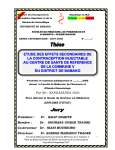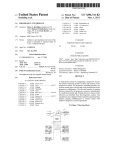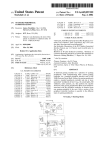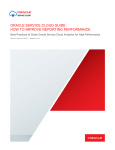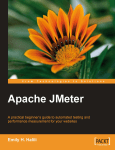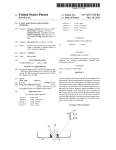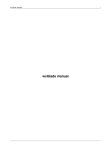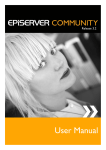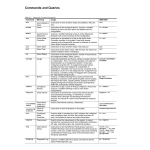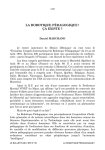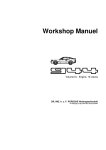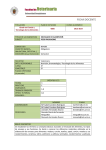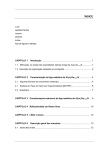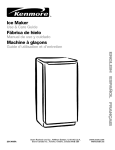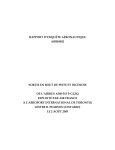Download System for billing usage of an automatic card handling device
Transcript
USOO8919775B2
(12) United States Patent
(10) Patent N0.:
Wadds et a].
(54)
(45) Date of Patent:
SYSTEM FOR BILLING USAGE OF AN
(58)
USPC ..................... .. 463/11*13, 16, 25, 29, 4(L43;
,
273/149 R
(71) Apphcam: 3313)), Gammg’ Inc" Las vegas’ NV
See application ?le for complete search history.
(72) Inventors: Nathan Wadds, Las Vegas, NV (U S);
(56)
References Cited
Colin Helsen, Henderson, NV (US);
U S PATENT DOCUMENTS
ZbignieW Czyzewski, Henderson, NV
' '
(US); James Helgesen, Eden Prairie,
MN (US); Russ Marsden, Las Vegas,
3,810,627 A
3,909,002 A
NV (U S)
(73) Ass1gnee: 331;]; Gaming, Inc., Las Vegas, NV
*
'
*Dec. 30, 2014
Field of Classi?cation Search
AUTOMATIC CARD HANDLING DEVICE
.
US 8,919,775 B2
.
'
( ) Notlce.
'
5/1974 Levy
9/1975 Levy
(Continued)
FOREIGN PATENT DOCUMENTS
'
'
EP
Subject to any d1scla1mer, the term ofth1s
1 502 631
W0
WO 97/10577
Al
patent 1s extended or adjusted under 35
_
U.S.C. 154(b) by 0 days.
(Con?rmed)
This patent is subject to a terminal dis-
OTHER PUBLICATIONS
Clalmer'
International Search Report for International Application No. PCT/
(21) Appl- NO-I 13/632,875
(22) Filed:
USO7/23168, dated Sep. 12, 2008, 3 pages.
Oct. 1, 2012
(65)
2/2005
3/1997
(Continued)
Prior Publication Data
Primary Examiner * Milap Shah
Us 2013/0045808 A1
Feb' 21’ 2013
(74) Attorney, Agent, or Firm *TraskBritt; Philip J.
Anderson
Related US. Application Data
(63)
(51)
C
'
'
'
ontmuatlon-m-part o
f
l'
'
app lcatlon
N
o.
11/558 818
,
(57)
,
_
ABSTRACT
_
_
_
_
?led on NOV 10, 2006, HOW Pat NO 8,616,552
An automatrc card handlmg deV1ce, havmg a card handh'ng
Int- Cl-
deV1ce that mcludes a controller, the card handlmg deV1ce
A63F 1/12
(2006-01)
con? gured for shuf?ing an inPut set of cards and delivering an
output set of cards resulting from the shuf?ing; and a com
A63F 1/14
G06F 1 7/00
G06F 19/00
(2006-01)
(2006-01)
(2011-01)
munication module operably coupled to the controller,
Wherein the communication module is con?gured for sending
and receiving information related to operation of the card
G0 7F 17/32
146317904
(52) U-s- Cl-
(2006-01)
(2006-01)
handling device across a communication port con?gured for
operable coupling to a cellular network, Wherein the infor
mation related to the operation of the automatic card handling
CPC --------- -- A63F 1/12 (2013-01); A63F 2009/2411
device includes information about the use of the card han
(2013.01); A63F 1/14 (2013.01); G07F 17/3234
(2013.01); G07F17/32 (2013.01); G07F
17/3293 (2013.01); G07F 17/3225 (2013.01)
dling device; and Wherein a factor in a usage fee for the card
handling device is use of the card handling device.
16 Claims, 9 Drawing Sheets
USPC .......................... .. 273/149 R; 463/25; 463/42
Communication
uo
Report
um:
Device
Generator
706
707
megjw
Mmmy
Dalia Module
102
712
Malmenanoe/
EnurMudu‘e
"/08
714
152
mg?“
shumsr
Communlnalmn
Mechanics
um
135
s
C535“
Va
Dewce
731
M
131
Card Handling Device
730
US 8,919,775 B2
Page 2
(56)
References Cited
US PATENT DOCUMENTS
4,339,798
4,467,424
4,531,187
4,586,712
4,750,743
A
A
A
A
A
7/1982
8/1984
7/1985
5/1986
6/1988
Hedges et a1.
Hedges et a1.
Uhland
Lorberetal.
Nicoletti
6,520,857 B2
2/2003 Soltys et a1.
6,527,271
6,530,836
6,530,837
6,533,276
6,533,662
6,579,180
3/2003
3/2003
3/2003
3/2003
3/2003
6/2003
B2
B2
B2
B2
B2
B2
s61tys et al.
s61tys et a1.
s61tys et a1.
SoltysetaL
SoltysetaL
Soltysetal.
6,579,181 B2
6/2003 $91tysetal~
6,582,301 B2
6/2003 H111
4,755,941 A
7/1988 Bacchi
6,588,751 B1*
7/2003 Grauzeret 31. ......... .. 273/149R
4,807,884 A
2/1989 Breeding
6,595,857 B2
7/2003 Soltys et a1.
4,861,041 A
8/1989 Jones etal.
6,629,894 B1
5,197,094 A *
3/1993 Tillery et a1. ................. .. 463/25
6,638,161 B2
10/2003
5,224,712 A
7/1993 Laughlin et a1.
6652379 B2
11/2003 SoltysetaL
5,257,179 A *
5,288,081 A
5,356,145
5,362,053
5,374,061
5,397,133
5,584,483
5,586,936
5,605,334
5,613,912
5,651,548
A
A
A
A
A
A
A
A
A
5,669,816 A
5,676,372
5,681,039
5,707,286
5,707,287
5,722,893
5,735,525
5,735,742
5,743,798
5,770,533
5,772,505
5,779,546
5,781,647
5,911,626
5,919,090
5,941,769
5,985,305
5,989,122
10/1993
DeMar ,,,,,,,,,,,,,,,,,,,,,,,,,, ,, 463/25
2/1994 Breeding
10/1994
11/1994
12/1994
3/1995
12/1996
12/1996
2/1997
3/1997
7/1997
Verschoor
Miller
Albrecht
Penzias
Sines et a1.
Bennett et a1.
McCrea, Jr.
Slater
French et a1.
9/1997 Garczynski et al.
A
A
A
A
A
A
A
A
A
A
10/1997
10/1997
1/1998
1/1998
3/1998
4/1998
4/1998
4/1998
6/1998
6/1998
Sines et al‘
Miller
Carlson
Mccreaplr‘
Hilletal'
MccreaJr‘
French
Adams et al‘
Franchi
Garczynski etal‘
A
7/1998
7/1998
6/1999
7/1999
8/1999
11/1999
11/1999
Meissneret 31‘
Fishbine et :11.
McCrea, Jr.
Mothwurf
Order
Peeryetal‘
Roblejo
A
A
A
A
A
A
10/2003 Purton
SoltysetaL
6,655,684 B2
12/2003
6,663,490 B2
12/2003 Soltys et a1.
6,676,127
6,676,517
6,685,568
6,688,979
6,712,696
6,726,205
6,749,510
6,758,751
6,774,782
B2
B2
B2
B2
B2
B1
B2
B2
B2
1/2004
1/2004
2/2004
2/2004
3/2004
4/2004
6/2004
7/2004
8/2004
GrauZeretal
Johnson et 31.
Beavers
SoltysetaL
Soltys et a1.
SoltysetaL
P9999
610be
Soltysetal.
Runyon etal~
6,834,251 B1
12/2004 Flétcher
6,848,616
6,848,994
6,857,961
6,893,347
6,899,628
6,964,612
7,011,309
7,029,009
7,036,818
7,059,602
B2
B1
B2
B1
B2
B2
B2
B2
B2
B2
2/2005
2/2005
2/2005
5/2005
5/2005
11/2005
3/2006
4/2006
5/2006
6/2006
Ts1r11ne etal.
Knust et a1.
Soltys et a1.
Zilliacus et a1.
Leen etal.
Soltys et a1.
Soltys et a1.
Grauzer et 31.
Grauzeret 31.
Grauzeret 31.
7,073,791 B2
B2
B2
B2
B2
7,128,652 B1
7,186,181 B2
7/2006
8/2006
9/2006
9/2006
10/2006
10/2006
3/2007
Grauzeret 31.
BaueretaL
Turtle
Garber et a1.
Grauzeret 31.
Lavoieetal.
Rowe
7,084,769
7,106,201
7,113,094
7,114,718
6,019,368 A
2/2000 Sines et al‘
7,203,841 B2
6,039,650 A
3/2000 Hill
7,297,062 B2
4/2007 Jackson et a1.
11/2007 Getto etal.
6,068,258 A *
5/2000 Breeding etal. ........ .. 273/149R
7,300,056 B2
11/2007 61911181111
6,069,564 A
6,071,190 A
5/2000 Hatano et a1.
6/2000 Weiss et a1.
7,303,473 B2
7,316,615 B2
12/2007 Rowe
1/2008 SoltysetaL
6,093,103 A
6,117,012 A
6,126,166 A
7/2000 McCrea, Jr.
9/2000 Mccreaplr‘
10/2000 Lorson et a1.
7,390,256 B2
7,510,478 B2
7,515,718 B2
6/2008 SoltysetaL
3/2009 Benbrahimetal.
4/2009 Nguyen etal~
6,149,154 A
11/2000 Grauzer etal,
7,666,090 B2*
2/2010 Herringer ~~~~~~~~~~~~~~~~~~~~~~ ~~ 463/25
6,154,131 A
11/2000 Jones, 11 etal.
7,686,681 B2
3/2010 $91tysetal~
6,165,069 A
12/2000 Sines et a1.
7,699,694 B2
4/2010 H!“ _
6/2010 C1mr1ngetal.
6,183,362 B1
2/2001 Boushy
7,744,452 B2
6,186,895 B1
2/2001 Oliver
7,780,529 B2
8/2010 Rowe etal.
6,200,218 B1
6,210,274 B1
3/2001 Lindsay
4/2001 Carlson
7,890,365 B2
7,908,169 B2*
2/2011 Hettinger ................. .. 705/14.12
3/2011 Hettinger ................. .. 705/14.12
6,234,900 B1
5/2001 Cumbers
7,909,689 B2
6,236,223
6,250,632
6,254,002
6,254,484
6,257,981
6,267,248
5/2001
6/2001
7/2001
7/2001
7/2001
7/2001
7,931,533
7,988,554
8,016,663
8,062,134
8092307
8,092,309
B1
B1
B1
B1
B1
B1
Bradyet a1.
Albrecht
Linnan
McCrea, Jr.
Acres etal.
Johnson et a1.
B2
B2
B2
B2
B2
B2
6,267,671 B1
7/2001 Hogan
6,270,404 B2
6,272,223 B1
8/2001 Sines et a1.
8/2001 Carlson
2002/0068635 A1
2002/0094869 A1
9/2001
Hessing et a1. .......... .. 273/1382
2002/0107072 A1*
Sines et al‘
Breeding etal,
Hill
Want et a1.
McCrea, Jr.
Stardust et a1.
Kim et a1.
s61tys et a1.
2002/0113368
2002/0142820
2002/0187830
2003/0003997
2003/0064798
2003/0067112
2003/0151194
2003/0195025
6,293,546 B1*
6,299,167
6299534
6,299,536
6,342,830
6,346,044
6,403,908
6,446,864
6,460,848
B1
Bl
B1
B1
B1
B2
B1
B1
10/2001
10/2001
10/2001
1/2002
2/2002
6/2002
9/2002
10/2002
8,337,296 B2*
A1
A1
A1
A1
A1
A1
A1
A1
3/2011 Lardie
4/2011
8/2011
9/2011
11/2011
1/2012
1/2012
LeMayetal
LeMayetal
Soltys et a1.
Kelly etal
Kélly
Blckley
12/2012 Grauzer et al. ............... .. 463/29
6/2002 Hill
7/2002 Harkham
8/2002
8/2002
10/2002
12/2002
1/2003
4/2003
4/2003
8/2003
10/2003
Giobbi ~~~~~~~~~~~~~~~~~~~~~~~~~~ ~~ 463/42
Hessing et al.
Bartlett
Stockdale et a1.
Vuong etal.
Grauzeretal.
Grauzeretal.
Hessing et a1.
Hill
6,517,435 B2
2/2003 s61tys et a1.
2004/0015423 A1*
1/2004 Walker et a1. ................. .. 705/34
6,517,436 B2
2/2003 s61tys et a1.
2004/0067789 A1
4/2004 Grauzeretal.
US 8,919,775 B2
Page 3
(56)
References Cited
US PATENT DOCUMENTS
2010/0048304 A1
2/2010 Boesen
2010/0069155 A1
3/2010 Schwartz et al.
2010/0178987 A1
7/2010 Pacey
2010/0197410 A1
2004/0100026
2004/0180722
2004/0224777
Zoos/0026680
A1
A1
A1
A1
5/2004
9/2004
11/2004
2/2005
Haggard
Giobbi
Smith et al‘
Gumrajan
2010/0234110
2010/0240440
2010/0255899
2011/0105208
8/2010 Leen et al.
A1
A1
A1
A1
9/2010
9/2010
10/2010
5/2011
Clarkson
Szrek et al.
Paulsen
Bickley
2005/0051955 A1
3/2005 Schubert et a1.
2011/0130190 A1
6/2011 Hamman et 31
Zoos/0051965 Al
3/2005 Gumrajan
2011/0159952 A1
6/2011 Kerr
2005/0082750 A1
4/2005 Grauzer et a1.
2011/0159953 A1
6/2011 Kerr
2005/0104290 A1
5/2005 Grauzer et a1.
2011/0165936 A1
7/2011
2005/0110210 A1
Zoos/0113171 Al
5/2005 Soltys et a1.
5/2005 Hodgson
2011/0172008 A1
2011/0183748 A1
7/2011 Aldeww
7/2011 Wilson et al.
2005/0137005
Zoos/0192092
zoos/0242500
Zoos/0272501
Zoos/0288083
2005/0288086
2006/0063577
2006/0183540
2006/0189381
2006/0199649
2006/0205508
2006/0252521
2006/0252554
2007/0072677
2007/0184905
2007/0197294
A1
A1
A1
A1
A1
A1
A1
A1
A1
A1
A1
A1
A1
A1
A1
A1
6/2005
9/2005
11/2005
12/2005
12/2005
12/2005
3/2006
8/2006
55/2006
9/2006
9/2006
11/2006
11/2006
3/2007
8/2007
Soltys et a1.
Breckner et 31‘
Downs, HI
Tran et al‘
Downs, HI
Schubert et a1.
Downs, 111 et a1.
Grauzer et al‘
Daniel et a1.
SOltys et al.
Green
Gururajan et a1.
Gururajan et a1.
LaVOie et a1.
Gatto et a1.
2011/0230268
2011/0269529
2011/0287829
2012/0015724
2012/0015725
2012/0015743
2012/0015747
2012/0021835
2012/0034977
A1
A1
A1
A1
A1
A1
A1
A1
A1
9/2011
11/2011
11/2011
1/2012
1/2012
1/2012
1/2012
1/2012
2/2012
Kerr
_
Wllllams
Baerlocher
Clarkson et 31.
Ocko et al.
Ocko et al.
Lam et al~
Ocko et al~
Keller et al.
Kammlef
FOREIGN PATENT DOCUMENTS
W0
WO
WO 2004/112923 A1
12/2004
2008/005286 A2
1/2008
OTHER PUBLICATIONS
2007/0197298 A1
8/2007 Gong
8/2007 RQWG
PCT International Search Report for PCT/US2007/022894, dated
2007/0202941 A1
8/2007 Miltenberger et al.
Jun 11 2008 2 pages
2318/th al'
Shuf?e Master Gaming, Service Manual, ACETM Single Deck Card
2008/0039192 A1
2/2008 Laut
Shuf?e”, 63 Pages, ©. 1998'
Zoos/0039208 A1
zoos/0096656 Al
2008/01 13700 A1
2/2008 Abrink et al‘
4/2008 LeMay et al‘
5/2008 CZyzeWSki et al‘
Shuf?e Master Gaming, Serv1ce Manual, Let It R1de Bonus® W1th
Universal Keypad, 112 pages, © 2000 Shuf?e Master, Inc.
Written Opinion of the International Searching Authority for Inter
Zoos/0113783 A1
5/2008 CZyzeWSki
national Application N0. PCT/US2007/022858, mailed Apr. 18,
2008/0176627 A1
7/2008
zoos/0234046 A1 *
2008/0234047 A1 *
9/2008 Kinsley “““““““““““““““ H 463/40
9/2008 Nguyen ,,,,,,,,,,,,,,,,,,, H 463/42
2008/0248875 A1
2009/0100409 A1
Lardie
2009/0224476 A1
2009/0298577 A1
10/2008
4/2009
9/2009
12/2009
Beatty
ToneguZZO
Grauzer et al,
Gagner et a1.
2009/0312093 A1 *
12/2009 Walker et a1. ................. .. 463/25
2003, 5 PageS~
_
.
.
_
_
_
.
_
_
Noti?cation of Transmittal of International Preliminary Examination
Report for corresponding International Application No. PCT/US02/
31105 ?led Sep- 27, 2002
PCT International Search Report and Written Opinion, PCT Appli
cation No. PCT?J82013/062391, Dec. 17, 2013, 13 pages.
* cited by examiner
US. Patent
Dec. 30, 2014
FIG. 1
Sheet 1 019
US 8,919,775 B2
US. Patent
Dec. 30, 2014
US 8,919,775 B2
Sheet 4 0f 9
/
l
{9502
w8~\/| 3|\
“@53%2
.GEv
V
Acvoi mou m
\
5
E
m
5
T
u
\
o.@2\l\!_8| m
u
_
_
Sm)
>
km2:
l92\ | .1~
325%-A||I|_Em\2:821
US. Patent
Dec. 30, 2014
US 8,919,775 B2
Sheet 5 0f 9
Ag*5sz
hI
e\)(lm2/oIc|uw
\
mm“<4
=‘
9QDex%\SQon
=
<
=
>
>
=
Q.52EQ
>mm“\O
m
ASm20fbo3tE$:-BZ /=|tI§\|j
Qg.mmmm.9&1
8“SNv2>m:
com
\§
.53an
“35¢
.GEm
US. Patent
(N(k8v%
Dec. 30, 2014
US 8,919,775 B2
Sheet 6 0f 9
E0It3
3 .K38
r
\
(Ev+=>E
E_UmOgaAQinl
$8W;5%5 5not FELonm?\fowa t.E2f%“j.:
PERic78A\v\
ho4bZsw
2mz5#op0ax?mr\
‘
_“
320%moanm/AV
vwVԤ\?aQ5xK3 %(smiw
1
R»_ m2..\1
m
.h
0
gxN§\mQax
A
Esu$£mo0t2.:3i2
8m
/(3mvN\|/< 0t.$o53sz
LILoE4ow
\map
32 5
.GE6
US. Patent
Dec. 30, 2014
Sheet 7 0f9
US 8,919,775 B2
Communication
NO
Report
Unit
Device
Generator
706
707
712
Frog?“
Maintenance/
MEEmory
Error Moduie
mg
734
Data Moduie
702
752
Netwch
720
“JV
751
P
D
m??? r
,
Camera
748
Shuf?er
Commun'jlcation
Mechanics
um
NO
Device
737
Processor
|/O
744
Device
7‘17
Memory
748
Memory
738
741
Sihuf?er
731
Card Handling Device
730
HG. 7
US. Patent
Dec. 30, 2014
Sheet 8 0f 9
Caiiect Shuf?er
Gate:
892
V
Send Data
894
V
Receive Data
896
V
Prepare
Reparts
898
V
$en§i data
reiated t0
reperts
816
PEG. 8
US 8,919,775 B2
US. Patent
Dec. 30, 2014
Sheet 9 0f9
i
Requeszt Qata
$61
+
(loiiect Shuffier
Data
$02
V
Send Bata
994
V
Receive Data
9%
F’repare
Repmrts
908
V
8am data
reiateci t0
repsrts
9‘5 9
PEG. 9
US 8,919,775 B2
US 8,919,775 B2
1
2
SYSTEM FOR BILLING USAGE OF AN
AUTOMATIC CARD HANDLING DEVICE
nance information, mechanical information, etc., can be sent
to a data module to prepare reports (typically formatted data
packets), such as detailed usage reports that enable the auto
matic card handling device to be licensed/billed based on
CROSS-REFERENCE TO RELATED
APPLICATIONS
use-based models rather than ?xed-time-period models. One
example of a ?xed-time-period model would be leasing a
smart shuf?er for $/month, regardless of actual use. For the
purposes of this disclosure, when a “8” sign is used it is
understood to conceptually include any recognized monetary
system and its symbol including, but not limited to, € , If, £,
F, £ , ‘P, ~11, Rs, W, [D] , etc. Examples ofuse-based models
include, but are not limited to, $/minute of powered-up time,
This application is a continuation-in-part of US. patent
application Ser. No. 11/558,818, ?led on Nov. 10, 2006,
which is hereby incorporated herein in its entirety by this
reference.
This application is related to US. patent application Ser.
No. 11/558,810, ?led Nov. 10, 2006, titled “Casino Table
Game Monitoring System,” now abandoned; US. patent
application Ser. No. 11/558,817, ?led Nov. 10, 2006, titled
“Method and Apparatus Providing Gaming Table with RFID
Antennas and Shielding,” now abandoned; and US. patent
application Ser. No. 11/558,823, ?led Nov. 10, 2006, titled
“Casino Card Shoes, Systems and Methods for a No Peek
$/card shuf?ed, $/card delivered, $/game-play (game-play
refers to a single game play sequence, such as one game of
blackjack from start to ?nish including any number of current
players), $/game-play/player (same as game-play, but the
charge rate includes an adder for each player), $/game-ses
sion (a game-session is a sequence of game-plays where each
Feature,” now abandoned, the content of each of which are all
hereby incorporated herein in its entirety by this reference.
20
$/game-session/average-player-count (same as $/game-ses
TECHNICAL FIELD
This disclosure relates generally to playing card handling
devices and, more speci?cally, to apparatuses comprising an
game play is the same game and the time interval between
each game-play is shortiseconds, not minutes or hours),
25
automatic card handling device for use in a cellular network.
BACKGROUND
sion, coupled with an adder for each additional player where
the number of players is averaged over a game session),
$/card-count, $/deck-check, etc. Some embodiments may
include the ability to not only charge for each type of use
event, but further to combine, or periodically total, charges
based on multiple types of use events that occur in one billing
period.
Card handling devices used in the gaming industry are used
30
for increasing the e?iciency, security and game speed in live
The data module can also receive maintenance and/or
mechanical information about the automatic card handling
device internals to prepare a report, alert, alarm and/or other
table games such as blackjack, baccarat and various forms of
poker. Card handling devices, such as card shuf?ers, may
noti?cation based on the information. In some embodiments,
perform a variety of functions including randomly shuf?ing
the data module receives information from internal compo
nents. In other embodiments, the data module may periodi
one or more decks of playing cards in an ef?cient and thor
35
cally collect information using polling methods, ?ushing
ough manner. In a live table game, it is important that the
playing cards are shuf?ed in an e?icient and thorough manner
to prevent players from having an advantage by knowing the
position of speci?c cards or groups of cards in the ?nal
arrangement of cards delivered in the play of the game. Addi
40
tionally, it is advantageous to have the playing cards shuf?ed
in a very short period of time in order to minimize any delay
in the play of the game.
There is a need for methods and apparatuses to provide
increased system e?iciency, reliability, and use details of a
speci?ed error or status buffers, or other methods, and collect
and format the data for transmission.
The data may be collected, formatted, and sent as a result of
a request for the information received at the data module from
an external source, typically a centralized server used to
access and, in some embodiments, further process the card
handling device (“smart shuf?er,” if the device is a shuf?er)
45
card handling devices.
data. The data may be collected, formatted, and/or sent as a
result of an internal request as well. Internal requests may be
of any form, including time-based and/or timer-based
requests, based on the occurrence or recognition of a speci?ed
set of detected or reported error conditions, and/ or sent inter
SUMMARY
nally as speci?cally requested by other internal modules.
Embodiments include an automatic card handling device
that, in one embodiment, comprises a shuf?ing apparatus that
is con?gured for shuf?ing an input set of cards and delivering
an output set of cards resulting from the shuf?ing. The auto
matic card handling device further comprises a detection
module con?gured for recognizing a rank and suit of each
50
BRIEF DESCRIPTION OF THE DRAWINGS
FIG. 1 is an illustration of one embodiment of an automatic
(“smart”) card handling device;
55
FIG. 2 is a block diagram of an automatic card handling
cards from the shuf?ing apparatus. Further included in the
device operably coupled to a local network;
FIGS. 3(a) through 3(c) are block diagrams of an embodi
ment of an automatic card handling device;
automatic card handling device is a communications module
FIG. 4 is a block diagram of an embodiment of an auto
card of the output set of cards. The detection module recog
nizes the rank and suit prior to removal of the output set of
that may communicate to remote computers or servers over 60 matic card handing device operably coupled to a local net
public cellular networks.
The communications module is con?gured for sending and
receiving information related to operation of the automatic
work;
FIG. 5 is a block diagram of a network of an embodiment
of an automatic card handling devices in accordance;
card handling device across a communication port that is
con?gured for operable coupling to a communication net
work, e.g., a cellular network. Information about the auto
matic card handling device, e. g., usage information, mainte
FIG. 6 is a block diagram of another embodiment of a
65
network of automatic card handling devices;
FIG. 7 is an illustration of an environment in which
embodiments may operate;
US 8,919,775 B2
4
3
122 located on top surface 112. A casino employee using the
FIG. 8 is a ?owchart of a method in accordance with an
card handling device 110 may monitor display panel 122 and
embodiment; and
view the displayed information in order to know the status of
FIG. 9 is a ?owchart of a method in accordance with an
operation of the card handling device 110. Such information
displayed on display panel 122 may include the number of
cards present in the card handling device 110, the status of any
embodiment.
The ?gures depict various embodiments for purposes of
illustration only. One skilled in the art who also has the bene?t
of this disclosure may recognize from the following discus
shu?ling, reading, or sorting operations, security information
sion that alternative embodiments of the structures and meth
relating to the card handling device 110, status relating to a
card veri?cation process, or any other information about
ods illustrated herein may be employed without departing
from the principles described herein.
errors, or the operation of card handling device 110 that
would be useful to a user. Buttons 113, 115, located adjacent
display panel 122 may be “on-off” buttons, special function
buttons (e.g., raise elevator to the card delivery position,
DETAILED DESCRIPTION
The present disclosure illustrates, in various embodiments,
reshuf?e demand, security check, card count demand, etc.),
apparatuses and methods of operation for an automatic card
and the like.
FIG. 2 illustrates an embodiment of a card handling device
handling device having cellular network capabilities (this
includes card handling devices that have other network inter
130 comprising a shuf?er 132 operably connected to a com
faces having similar capabilities as public cellular networks).
In the following description, circuits and functions may be
puter 134. Computer 134 may be any operable implementa
shown in block diagram form in order not to obscure the
tion including, but not limited to, a chip or chipset that sup
20
descriptions in unnecessary detail. Conversely, speci?c cir
cuit implementations shown and described are examples only
example is Qualcomm’s Snapdragon series of chips (other
manufacturers, such as Intel, also sell chips that enable public
cellular telephony communications). Other embodiments
and should not be construed as the only way to implement
cellular shuf?ers unless speci?ed otherwise herein. Addition
ally, block de?nitions and partitioning of logic between vari
may include several components, of which a subset may be
25
ous blocks illustrates one possible embodiment. It may
become apparent to one of skill in the art, who also has the
may be practiced by various other partitioning solutions, all
30
operable coupling to network 136 via communication link
290. Computer 134 may also be operably coupled to printer
and/or assemblies within embodiments of cellular card han
dling devices, and is not be construed as requiring a particular
138 via communication link 296 or via network 136.
35
ments for performing the indicated functions.
When executed as ?rmware or software, the instructions
may be stored on a computer readable medium. A computer
40
45
114 which, when opened, exposes a card insertion area 116
and an elevator platform 118. Card insertion area 116 may be
con?gured to receive an input set of cards to be shuf?ed,
counted, and/or sorted. In one example, card handling device
110 may be con?gured to receive, read rank and suit, sort, and
shuf?e multiple, e.g., up to 8, decks of cards at any one time.
Elevator platform 118 may be con?gured to raise a set of
50
55
separate enclosure. In all embodiments, communication
60
?ush-mounted into a gaming table in a casino where a live
card game is taking place, or may be located in a remote
location off the casino ?oor, which is inaccessible to the
Card handling device 110 may also be con?gured to dis
play operational data relating to the device to a display panel
telephony, can also be used as they are developed in the
future.
As described in more detail below, communication module
146 may be con?gured to establish communication with net
work 136 and thereafter send and receive information to and
from network 136 across communication port 148.
In some embodiments, communication module 146 and
memory 800 reside within the shuf?er 132; in others, the
communication module 146 and memory 800 may be in a
module 146 is in operable communication with shuf?er con
Card handling device 110 may be located adjacent to or
public.
red communication, IEEE 802.16 (or WiMax), IEEE
802.11a/b/g/n/p, Wi-Fi, and in particular for one embodi
ment, any public cellular phone network including, but not
limited to, GSM, CDMA, 3G, or 3GPP Long Term Evolution
(LTE), communication, etc. It is envisioned that other com
cesses are completed. Elevator platform 118 may include a
sensor 120, which detects the presence of cards or other
objects located on elevator platform 118. A camera 142 or a
card recognition module 146 (see FIGS. 2 and 3) may also be
included within the body 124 of card handling device 110.
any combination thereof. By way of example and not limita
tion, communication links 290 and 296 may be comprised of
serial data links, parallel data links, USB, Ethernet, a Wide
Area Network (WAN), a Local Area Network (LAN), infra
munications technologies, especially those used for public
shuf?ed cards to a level where they can be removed by a
device user after the shuf?ing, reading, and/or sorting pro
Network 136 may comprise a local network or a wide area
network, such as the Internet, cellular phone network or some
combination of networks. Communication links 290 and 296
may comprise any form of wireless or wired connections or
for performing the methods and processes described herein
readable medium includes, but is not limited to, magnetic and
optical storage devices such as disk drives, magnetic tape,
CDs (compact discs), DVDs (digital versatile discs or digital
video discs), and semiconductor devices such as RAM,
DRAM, ROM, EPROM, and Flash memory.
FIG. 1 illustrates a card handling device 110. A top surface
112 of card handling device 110 may comprise a ?ip-up cover
ably coupled to computer 134 by connections 292 and 294,
respectively. Computer 134 may comprise a communication
module 146 and a communication port 148 con?gured for
sense and solely to indicate functionality of particular circuits
physical structure, or particular partitioning between ele
the QUALCOMM® or INTEL® chips already mentioned.
Shuf?er 132 may include a shuf?er controller 140, and a
camera processor 144 operably coupled to camera 142. Shuf
?er controller 140 and camera processor 144 are both oper
bene?t of this disclosure, that the embodiments disclosed
of which are contemplated herein.
Further, the term “module” is used herein in a non-limiting
ports public cellular communications capabilities. One
65
troller 140. In some embodiments, other modules or compo
nents of the shuf?er 132 may also be in communication with
communication module 146 in addition to the shuf?er con
troller 140.
In one embodiment, upon shuf?er 132 receiving an input
set of cards, shuf?er controller 140 is con?gured to count the
cards and, as the cards are being counted, camera 142 is
con?gured to take a picture of at least a portion of each
US 8,919,775 B2
5
6
counted card. Thereafter, data representing pictures and a
receive information over the network. Further included in
card recognition module 154 is a detection module 219 con
card count are sent to computer 134, which iterates through
the pictures and extracts the card value from the picture of
?gured for verifying the contents of an input set of cards, and
a diagnosis module 212 con?gured for performing a self
diagnosis on the operation of card handling device 150, as are
explained more fully below.
FIG. 3(b) illustrates a physical partitioning embodiment of
card handling device 150' wherein the card recognition mod
each card. In another embodiment, the information is sent to
a one or more computing device(s) across a WAN (e.g., Inter
net and/or cellular network). Computer 134 then generates
information relating to the input set of cards by associating
the value of each individual card with its counted position in
the deck. The card information is then used by the computer
134 to verify the contents of the deck by comparing the
information relating to the input set of cards to information
ule 154' comprises a custom module 228 including custom
logic con?gured to establish communication with a network
and thereafter transmit and receive information over the net
work. The custom module 228 may include logic con?gured
for performing the functions of the communication module
146, the detection module 219, and the diagnosis module 212.
By way of example and not limitation, the custom module 228
may be implemented as a custom application speci?c inte
grated circuit (ASIC), a ?eld programmable gate array
(FPGA), one or more programmable logic devices (PLDs)
relating to a standard deck of cards stored in the memory 800
of computer 134. Computer 134 may be con?gured to operate
in multiple modes and may be capable of automatically
switching between multiple modes without powering off or
rebooting. By way of example, computer 134 may be con?g
ured to operate in a set-up mode, ran mode, or a service mode,
as are explained more fully below.
As described above, card handling device 130 is con?gured
to display, on display panel 122 (see FIG. 1), any data per
taining to the operation of card handling device 130. Card
handling device 130 may be further con?gured to convert the
aforementioned operational data into electronic data signals
comprising information such as, repair-related data, data
related to current or past operation and use, the serial number
20
and similar devices for implementing custom logic as are
known to those of ordinary skill in the art.
25
In another embodiment of card handling device 150", card
recognition module 154" may comprise, as illustrated in FIG.
3(c), a microcontroller 222 operably coupled to a memory
module 224. Microcontroller 222 may be con?gured to per
form the functions of the communication module 146, the
detection module 219, and the diagnosis module 212 (see
FIG. 3(a)). As such, microcontroller 222 may be con?gured
of the card handling device 130, the serial numbers of device
parts, physical location of card handling device 130, perfor
to establish communication with a network and transmit and
mance, usage, or any other data related to card handling
device 130. At any time after communication has been estab
lished by computer 134, communication module 146 may
transmit the information through communication port 148
receive information over the network by employing software
30
and across network 136 via communication link 290. As
described in greater detail below, the information may then be
Therefore, a memory module 224 external to the microcon
troller 222 may not be necessary.
transmitted to a server 162 where the data can be viewed by a
device operator, stored, mined, or forwarded to casino per
sonnel or a service center 168 (see FIGS. 5 and 6). Addition
35
In another embodiment, card recognition module 154"
may include a hardware communication module 226. In this
con?guration, the communication function may be imple
ally, computer 134 may be con?gured to send information
comprising the shuf?ing and card veri?cation results to a
printer 138 via communication link 296. Printer 138 may be
con?gured to, upon receipt of the information, print a label
or ?rmware stored on memory module 224. Of course, many
microcontrollers suitable for the card recognition module
154", may include memory as part of the microcontroller 222.
40
with the veri?cation results, which may then be a?ixed to the
mented completely in hardware, or may be a combination of
hardware and software functions con?gured to establish com
munication with a network and thereafter transmit and
receive information over the network.
output set of cards, for example. The printer 138 could also
Although the card recognition 154 module in the ?gures is
print a wide variety of messages, such as service requests,
hours of operation, number of batches of cards shuf?ed, par
ticular cards missing, and the like.
shown as part of the shuf?er 156, in other embodiments, the
card recognition module 154 may be located in an external
computer that communicates with the shuf?er controller. In
some embodiments, the communication can be direct, indi
rect, via a LAN, via a WAN including public cellular net
45
FIGS. 3(a) through 3(c) illustrate various embodiments of
card handling device 150. FIG. 3(a) illustrates a logical par
titioning of functions within the card recognition module 154,
whereas FIGS. 3(b) and 3(0) illustrate different embodiments
of physical partitioning of the card recognition module 154.
Of course, these partitioning solutions, both logical and
physical, are example solutions; other embodiments with dif
ferent partitioning solutions are fully contemplated.
As illustrated in the logical partitioning of FIG. 3(a), card
handling device 150 includes a shuf?er 156 and a card rec
ognition module 154. Shuf?er 156 includes a sensor module
works, a wired network/links, or any combination.
FIG. 4 illustrates another embodiment wherein card han
50
tion module 154 operably coupled together by way of con
nection 380. Additionally, card recognition module 154 may
comprise a communication module 146 and a communication
55
214 that is operably coupled to card recognition module 154
via connection 380 and is con?gured for sensing image infor
mation about each card included in an input set of cards. The
sensor module 214 may include, for example, a two-dimen
sional CMOS image sensor, a two-dimensional charge
coupled device (CCD) image sensor, or a one-dimensional
line sensor, as are known by those in the art. Card recognition
module 154 comprises a communication module 146 con?g
ured for establishing communication with a local network or
a world-wide network, including a public cellular network.
Communication module 146 may be further transmit and
dling device 150 is coupled to network 136. Card handling
device 150 may comprise a shuf?er 156 and a card recogni
60
port 148 directly coupled to network 136 via communication
link 290. Card recognition module 154 may also be operably
coupled to printer 138 via communication link 296. As
described above, communication module 146 may be con?g
ured to establish communication with network 13 6 and there
after send and receive information over network 136, which,
as described above, may comprise a local network and/or a
wide area network, such as the Internet, public cellular net
work, etc. Communication links 290 and 296 may comprise
any form of wireless or wired connections or any combination
65
thereof.
The operation of card handling device 150 depicted in FIG.
4 will now be described. As a set of input cards is placed into
US 8,919,775 B2
7
8
card handling device 150, shuf?er controller 156 is con?g
162 may be accessed by a device operator within operator
station 500. Conversely, if server 162 is located outside of
operator station 500, any data received at server 162 may be
forwarded to operator station 500. As such, a device operator
accessing operator station 500 may receive the information
and monitor the status of each card handling device 160.
Upon receipt of any information, server 162 may be con?g
ured to store, mine, assemble, or forward the information to
ured to shuf?e the input set of cards, and sensor module 214
captures image information about each card, either before,
during or after the shuf?ing process. The image information is
sent to the card recognition module 154 where the detection
module 219 (see FIG. 3(a)) processes the image information
for each card to determine the rank and suit of each card. The
image information may be transformed into a rank and suit by
an image recognition process of the rank and suit designa
casino personnel or to a device technician located within
tions on each card. As explained earlier, the image recogni
service center 168. For example only, casino personnel or a
device technician may receive the transmitted information by
tion process may be performed as software/ ?rmware operat
ing on the microcontroller 222 or may be performed by
custom logic within the custom module 228 (see FIGS. 3(a)
way of a graphical user interface (GUI) comprising a visual or
alerting system on a computer, cell phone, or other like data
3(c)). Card recognition module 154 may be con?gured to
operate in multiple modes and may be capable of automati
receiving device.
By way of example only, card handling device 160 may be
cally switching between multiple modes without powering
con?gured to transmit an email or a text message, containing
off or rebooting. By way of example, card recognition module
the operational status of card handling device 160, to server
154 may be con?gured to operate in a set-up mode, a run
162 or directly to a cellular phone network. If transmitted to
mode, or a service mode.
operator station 500, it may then transmit the email, text
message, instant message and/or other messaging type, to
service center 168 or any data receiving device belonging to
In addition to shuf?ing and verifying the contents of an
input set of cards, card handling device 150 may, at any time
while powered on, establish communication with network
136. Thereafter, card handling device 150 may transmit the
results of the shuf?ing and veri?cation processes or any other
data relating to the card handling device 150, such as, diag
nostic messages, identity messages, simple or complex usage
20
casino personnel. A transmitted email or text message may
comprise, for example, information detailing whether the
input set of cards has successfully passed the shuf?ing and
25
contain the reasons for failure, and may list the missing card
or cards should the card handling device 160 detect a missing
data, and location messages over network 136 to server 162
(see FIGS. 5 and 6). Furthermore, card recognition module
154 may be con?gured to send information comprising the
shu?ling, maintenance information, power, operational infor
card or cards. Other data contained in an email, text message,
30
or the like, may comprise information identifying the location
of the card handling device 160, the name and location of the
casino, and directions to the casino as well as the casino pit
where the card handling device 160 resides. Card handling
device 160 may also be con?gured, upon diagnosing a prob
35
lem, to transmit an alert or a request across network 136 to
server 162, or, to transmit an alert over a public cellular
mation, and card veri?cation results to a printer 138 by way of
communication link 296. Printer 138 may be con?gured to,
upon receipt of the information, print a label or other report
with information such as veri?cation results that can then be
a?ixed to the output set of cards.
FIG. 5 illustrates an embodiment comprising a network of
veri?cation processes. If the input set of cards has failed the
veri?cation process, a transmitted email or text message may
card handling devices 160. Card handling devices 160 may be
network to a preselected destination, including a central
located on a casino ?oor adjacent a playing table or in a
server at a casino (operator’s property) and/or a server at the
back-room location off the casino ?oor and may be comprised
of either card handling device 130 described in FIG. 2, or card
handling device 150 described in FIGS. 3(a)-3 (c) and 4. Each
card handling device 160 is operably coupled to a network
136 over corresponding communication links 290. Network
136 may be operably coupled via communication link 490 to
card device manufacturer’s location. Further, server 162 may
forward the alert or request to operator station 500, casino
personnel, or to service center 168.
a server 162 located within operator station 500, which is a
40
Card handling device 160 may also be con?gured to gen
erate a report comprising a description of the location and
45
computerized machine control system. Operator station 500
and server 162 may be located within the casino property and
may be operably coupled to printer 138 and a world-wide
network, such as the lntemet or a public cellular network, 164
by communication links 296 and 163, respectively. Server
50
162 may be located within operator station 500, as shown in
dling device 160 and, thereafter, may address current prob
lems or future problems that may eventually exist in the
may be located either on the casino property or at a remote
55
LAN, WAN and/or other network 164 via communication
Additionally, the card handling device 160 may be con?g
60
depicted in FIG. 5 will now be described. At any time while a
device 160 may establish communication with network 136
and thereafter transmit any information pertaining to the card
operator station 500. Therefore, any data received by server
ured to receive information comprising messages and instruc
tions such as, work commands or a self-diagnosis request
from a device operator located within operator station 500, a
service center 168, or directly to an individual card device
card handling device 160 is powered on, the card handling
handling device 160 across network 136 to server 162. As
illustrated in FIGS. 5 and 6, server 162 is located within
corresponding card handling device 160. The report could
generate a repair request, a preventative maintenance request,
could identify the card handling device 160 as requiring a
software upgrade, etc.
links 494 and 163. Communication links 163, 290, 296, 490,
and 494 may comprise any form of wireless or wired connec
tions, or any combination thereof.
The operation of the network of card handling devices
mitted electronically over network 136 to server 162, and/or
to a server using a public cellular telephony connection.
Server 162 may also forward the report to service center 168,
or to a computer, cell phone or any other data receiving device
belonging to a device technician or casino personnel. Upon
receipt of a generated report, casino personnel or a device
technician can quickly locate the corresponding card han
FIG. 5, or may be located separate from, and operably
coupled to, operator station 500. A service center 168, which
location, may be operably coupled to server 162 across a
relative performance of all the operational elements of card
handling device 160. The generated report may then be trans
over its own public cellular telephony connection. As such, in
65
addition to monitoring multiple card handling devices 160, a
device operator located within operator station 500 may con
trol multiple card handling devices 160 at any given time.
US 8,919,775 B2
10
such cases, the hardware and software components of the
Additionally, a technician, located at a remote location such
as service center 168, may perform troubleshooting routines
operator or the card handling device owners would be com
or install software or ?rmware upgrades and patches on card
patible with cellular technology rather than, say, a hardwired
LAN technology. Further, in some embodiments each card
handling device will have both hardwired LAN and cellular
WAN capabilities, and will be con?gured to use each network
for different or perhaps overlapping purposes as pro grammed
by the card device programmers. Card handling devices 160B
handling devices 160 by using public cellular telephony com
munication links.
As described above, card handling device 160 may be
con?gured to operate in multiple modes and may be capable
of automatically switching between modes without powering
may transmit and receive messages to and from pit server
664B over local pit network 170B.
off or rebooting. As such, a device operator may simulta
neously control multiple card handling devices 160 by chang
ing the operation mode of a card handling device 160 and
thereafter running programs on, sending data requests, or
sending work commands to the card handling device 160. By
In addition, local pit networks 170A/170B may be oper
ably coupled to server 162, via communication link 592.
Server 162 may be operably connected to a printer 138 via
communication link 296. Service center 168 may be operably
way of example and not limitation, a device operator or owner
remotely located from any card device 160 may, using each
card device’ s cellular connectivity, switch any particular card
coupled to server 162 across a wide area network 164, e.g.,
Internet, cellular network, etc., via communication links 494
and 163. In addition to transmitting and receiving information
to and from the pit server 664A/664B, each card handling
handling device 160 to a service mode and request a self
diagnosis, conduct troubleshooting routines, or install soft
ware updates and patches. Additionally, card handling device
160 may, upon receiving an input set of cards, automatically
20
switch to a set-up mode and activate a calibration check in
order to verify proper calibration before switching to a run
mode to thereafter shuf?e and/or verify the input set of cards.
device 160A/160B may, as described above, transmit and
receive information to and from server 162 across local pit
network 170A/170B and/or equivalently over a cellular net
work, or combination thereof. As such, a device operator
according to a common trait, such as physical location and/or
located within operator station 500 may simultaneously
monitor and control each card handling device 160A/160B of
each local pit network 170A/170B. The operational data
transmitted from each card handling device 160A/160B and
game type. For example only, a network of card handling
received at server 162 may be viewed by a device operator,
devices 160A located on a single casino ?oor or within a
stored, mined, assembled, and/or simultaneously viewed by
FIG. 6 illustrates another embodiment comprising a net
work of card handling devices 160A networked together
25
limited area of a single casino ?oor may be networked
together. Likewise, for example, a network of card handling
service center 168 when each device uses its cellular connec
30
tion (not shown in FIG. 6). Additionally, the operational data
devices 160A pertaining to a speci?c game type, such as
may be transmitted to a computer, cell phone, or like data
blackjack, may be networked together. Each card handling
receiving device belonging to casino personnel. Communi
device 160A in a similar network is operably coupled by
cation links 296, 494, 590, 592, 594A, and 594B may com
communication link 590A to a local pit network 170A, which
may correspond to, as described above, the location or the
prise any form of wireless or wired connections or any com
35
bination thereof.
game type of the card handling device 160A. Each local pit
network 170A is, in turn, operably connected by communi
Additionally the card handling device 160A/160B may be
con?gured to receive information comprising messages and
cation link 594A to a local pit operator station 172A. As
illustrated in FIG. 6, pit server 664A is located within pit
request from a device operator located within operator station
operator station 172A. Therefore, any data received by pit
instructions such as, work commands or a self-diagnosis
40
500 or over its cellular connection. As such, in addition to
monitoring multiple card handling devices 160A/160B, a
server 664A may be accessed by a device operator within pit
operator station 172A. Conversely, pit server 664A may be
located outside of pit operator station 172A and any data
received at pit server 664A may be forwarded to pit operator
station 172A. In addition, each card handling device 160A or
160B has its own cellular phone connections over which it
may communicate, and be communicated to, the same per
sonnel just described, as well as personnel associated with a
lessor or owner of the card devices (which may different than
45
such as service center 168, may perform troubleshooting
routines or install software upgrades and patches on card
handling device 160A/160B by using an electronic commu
nication link between the card handling device 160A/160B
and a computer (not shown), or a cellular telephony link, to
the casino operators).
50
service center 168.
FIG. 7 is an illustration of an environment in which
device operator located within operator station 500 may con
trol multiple card handling devices 160A/160B at any given
time. Additionally, a technician, located at a remote location
As described above, at any time while powered on, each
card handling device 160A located within a local pit network
170A may be con?gured to establish communication with
local pit network 170A, and transmit information relating to
its operation to pit server 664A. Also, each card handling
55
device 160A may be con?gured to receive messages or
instructions from pit server 664A. As such, a pit operator,
located within pit operator station 172A, may simultaneously
monitor and control each card handling device 160A located
in the corresponding local pit network 170A. Each card han
60
dling device 160B may be networked together and directly
include physical components and subcomponents of shuf?er
731. Examples of such components are described herein with
reference to FIG. 2, for example. In some embodiments, the
operation of the camera 740 is similar to the operation of
coupled to a local pit network 170B in a similar fashion as
described above in reference to each card handling device
160A; alternatively each card handling device 160A may be
in communication with various servers using its cellular tele
embodiments may operate. A card handling device 730 can be
similar to the card handling device 130 described herein. Card
handling device 730 includes a shuf?er 731 and computing
device 741, the operation of which, in many respects, can be
similar to card handling device 132 and computer 134
described herein. In an embodiment, the shuf?er 73 1 includes
a processor 734, shuf?er mechanics 736, a camera 740, input/
output device 737, and memory 738. Shuf?er mechanics
65
camera 142, described herein.
The computing device 741 includes a processor 744, a
phony capabilities, resulting in the same functionality results
communication unit 746, an input/output device 747 and
as far as operators or owners of the devices are concerned. In
memory 748. Data module 702 includes a processor 704,
US 8,919,775 B2
11
12
communication unit 706, input/output device 707, memory
includes a report generator 712 and a maintenance/error mod
ule 714. A feature of some embodiments is that information
708, report generator 712 and maintenance/ error module 714.
The processors 734, 744, 704 process data signals and may
comprise various computing architectures such as a complex
instruction set computer (CISC) architecture, a reduced
instruction set computer (RISC) architecture, or an architec
about the automatic card handling device 730, e.g., usage
information, maintenance information, mechanical informa
5
ture implementing a combination of instruction sets.
tion, etc., canbe sent to data module 702. The report generator
712 prepares reports such as detailed usage reports that
enable the automatic card handling device 730 to be licensed/
Although only a single processor is shown, multiple proces
billed based on metrics such as per use, per session, per game
sors may be included. The processors 734, 744, 704 comprise
an arithmetic logic unit, a microprocessor, a general purpose
computer, or some other information appliance equipped to
transmit, receive and process electronic data signals from the
play event, per session, per time period, etc.
The report generator 712 receives usage information from
the card handling device 730 and identi?es usage based on
various usage parameters. Examples of such usage param
eters include, (a) number of shuf?es, (b) number of cards
memory 738, 748, 708, the input/ output device 737, 747, 707,
shuf?ed, (c) number of game play events, (d) number of game
shuf?er mechanics 736, and camera 740.
The memory 738, 748, 708 stores instructions and/ or data
that may be executed by processor 734, 744, 704. The instruc
tions and/ or data may comprise code for performing any
and/or all of the techniques described herein. Memory 738,
748, 708 may be a dynamic random access memory (DRAM)
device, a static random access memory (SRAM) device,
Flash RAM (non-volatile storage), combinations of the
sessions, and/or (e) use of card handling device 730 in a time
period, such as an hour or a de?ned multiple hour period such
as a 24 hour period having any start time, for example.
The parameter of the number of shuf?es can represent the
number of full deck shuf?es performed by the card handling
20
above, or some other memory device known in the art. While
the memory 738, 748, 708 is shown on the devices 702, 731,
741, some of the memory can be remote, e.g., on a separate
device connected to the device or via a WAN, e.g., a cloud 25
based storage device.
Input/output device 737, 747, 707 provides an interface
once when the card is part of a shuf?e process in which one or
more decks of cards are completely shuf?ed.
The parameter of a game play event can represent the
con?gured to provide inputs, send outputs to the device. Input
devices can enable a user the ability to provide inputs to the
input/output device 731, 741, 702. Output devices can be any
device equipped to display electronic images and/or data.
30
Computing device 741 may be a part of shuf?er 731 or may
be a device separate from the card handling device 730, for
example. In an embodiment, computing device 741 includes
a communication unit 746 that communicates with network
720 via communication link 751. The network 720 also com
municates with data module 702 via communication link 752.
device 730. When multiple decks are shuf?ed, the parameters
can re?ect the total number of decks shuf?ed. The parameter
of the number of cards shuf?ed can represent the number of
cards shuf?ed by the card handling device 730. In an embodi
ment when a particular card is shuf?ed multiple times over the
course of a time period, the parameter is incremented each
time the card is shuf?ed. In an embodiment, a card is shuf?ed
35
number of completed games/hands at a table. For example,
one game play event for blackjack represents the dealing of
cards between the placement of an initial bet and the ?nal
result of the hand. In one embodiment, if there are ?ve players
at a table, the completion of one hand for all players and the
dealer represents ?ve game plays, in some embodiment the
dealer’s hand is also counted so this represents six game
plays, in another embodiment this represents one game play.
Network 720 can be any network, e.g., LAN, WAN, e.g., the
The parameter of a game session can represent a series of
Internet, public cellular network, etc. The communication
units 706, 746 can communicate using one or more of follow
game plays/deals for a particular type of game played such as
blackjack, THREE CARD POKER®, etc., without a signi?
cant break in play. For example, if a card handling device 730
is used for THREE CARD POKER® and is in continuous
ing communications methods: cellular protocols (e.g., GSM
(Global System for Mobile Communications), TDMA,
CDMA, etc), infrared communication, IEEE 802.1 la/b/g/n/p
minute break (other break period criteria can be used), for six
hours, then the card handling device 730 is used forblackj ack,
links 751, 752 can be wireless/wired or a combination 40
thereof, for example. In an embodiment the communication
use, e. g., shuf?ing and dealing cards with no more than a ?ve
45
then the six hours of THREE CARD POKER® is one game
communication, 3 G communication, 3GPP Long Term Evo
lution (LTE), IEEE 802.16 (or WiMax) communication, or
other radio frequency communication. It is envisioned that
play session.
other protocols/communication methods can be used.
Although only one card handling device 730 is illustrated
in FIG. 7, in some embodiments, multiple card handling
50
The parameter of use in a period can represent the total
amount of usage of the card handling device 730 in a period.
Examples of usage are number of shuf?es, number of cards
shuf?ed, number of game play events, and/or game sessions.
devices 730 communicate with data module 702. In an
The data module 702 can identify usage over any period for a
embodiment, each card handling device 730 can communi
cate directly with the data module, for example, via network
720. In one example, multiple card handling devices 730
handling devices 730 where the collection can be in the same
area of the casino ?oor, in the casino, or in different casinos,
single card handling device 730 and/or a collection of card
55
for example. The information can assist in identifying trends
in the amount of game plays of particular games, e.g., THREE
include communication units 746 that have a cellular modem
to enable communication with one or more data modules 702
CARD POKER®.
The data module 702 can also receive maintenance and/or
via a cellular communication network 720. In another
embodiment, multiple card handling devices 730 can be
coupled to a single device having a communication unit that
is capable of connecting to network 720. In one example,
multiple card handling devices 730 are coupled to a device
that is capable of communicating with data module 702 via a
cellular communication network.
In some embodiments, data module 702 is positioned such
that communication between data module 702 and card han
dling device 730 goes through network 720. Data module 702
60
mechanical information about the automatic card handling
device 730 and the maintenance/error module 714 can pre
pare a report, alert, alarm and/or other noti?cation based on
the information. For example, the maintenance/error module
714 can identify when a component/sub-component of a card
65
handling device 730 is nearing an end-of-life metric and
should be replaced. For example, different components/sub
components (mechanisms) of the card handling device 730
US 8,919,775 B2
13
14
can wear at different rates depending on how the shuf?er 731
typically be used when the card handling device 730 detects
that a certain (preselected) type of log or interrupt event
is used. In one example, card handling devices 730 perform
different tasks and, therefore the use of various sub-compo
occurs. When these types of events occur, it has been prede
termined that these events will be reported immediately, or, in
a relatively short time frame compared to the regular reports.
nents differ, depending upon the game being played. Accord
ingly, the wear rate of some sub-components can vary based
on the game being performed by the card handling device
“Preselected” means that the types of events that are to be
730. The maintenance/error module 714 or the card handling
device 730 or a processor coupled thereto, can keep track of
reported to a central location using networked connections, in
the usage of various components/sub-components of the card
handling device 730 and identify when such a component/
sub-component is approaching an end-of-life usage param
the regularly timed sending of data, and, has been selected in
one embodiment, a cellular connection, occurs sooner than
some manner so the card handling device can determine,
algorithmically, that the data is to be sent. In one embodiment,
the card handling device is programmed so that when it
detects fault interrupts or log entries that indicate a failure
mode, the data indicating those conditions is sent as soon as
eter.
The maintenance/ error module 714 can also identify when
a component of the card handling device 730 has broken and
needs repair or when the card handling device 730 is other
wise not operating properly, e.g., when the rate of erroneous
5
shuf?es exceeds a threshold. The maintenance/ error module
714 may be able to anticipate a failure based on improper
operation and can send a message informing the recipient that
maintenance should be done; this message can be prior to the
20
failure of the card handling device 730.
below, the data module 702 receives information from the
card handling device 730 as a result of a request for informa
25
location, a report may be sent as soon as technically practi
cable. Other disallowed uses, such as certain games, may also
trigger the sending of data soon as soon as technically prac
30
ticable after detection.
Failure or unauthorized use may also be detected by data
module 702 when it cannot communicate with any particular
card handling device 730. If a regularly scheduled report does
not arrive at data module 702 when expected, that indicates
the device is unable to communicate due to device failure, due
to a networking failure, due to communications being pur
35
no network capabilities, or other failures. Data module 702
rectly.
FIG. 8 is a ?owchart of a method in accordance with an
embodiment. The information about card handling device
730 is collected 802. As described above, the information can
include usage data, error data or any other data related to the
card handling device 730. For discussion purposes, it can be
characterized as comprising two types of data. One is usage
data, that is, data based on, and/or reporting, the type and
kinds of use the card handling device card has been put to.
Another is fault, error, and condition reporting. Note, that in
actuality, there is always some overlap between these types of
data and their use. For example, predictive maintenance and
failure reports may be generated, in part or in whole, based on
usage data and/or fault, error, and/or condition data. Billing
reports, which are often based on usage data, may also include
billable events due to failure, error, or predictive maintenance
data that is used to generate a billable event, used to generate
a billing report, or bill, to the user of the card handling device
730.
In an embodiment, usage data can include data related to
earlier. In addition to events that do, or might, indicate a
failure of some kind, other reportable events that may be sent
as soon as possible after detection may be events that indicate
an improper use by the user of the device. For example, if the
card handling device is licensed to the user for speci?c loca
tions and the device detects, using GPS or cellular tower
location technologies, that it has been moved to unlicensed
In some embodiments, and as described in greater detail
tion. In other embodiments, the data module 702 receives the
information without a prior request either directly or indi
technically feasible. Other events may be selectably program
mable to send during the regular data sending periods, or
posefully blocked, being in an unauthorized location that has
may be programmed to re-try communications with card
handling device 730 for a predetermined number of tries,
and/or over a predetermined time period, after which it gen
erates a report or alarm. An example of an alarm may be a
40
report indicating it is of high importance, highlighting of the
event on a user interface (lights, sounds, vibration, etc.), or
other means indicating that the event requires attention by
associated personnel. Note that the re-try settings including,
45
but not limited to, attempts to establish communicate and/or
attempts over a time period, may be quite short or small by
human standards, such as micro- or milliseconds, for
the type of game, the number of cards shuf?ed, the number of
example, and may be dependent on the device, its location,
cards dealt and in one embodiment will include a time stamp,
50
the local infrastructure, and other factors. In one embodiment,
the parameters associated with detection of a communica
tions fault or non-responsive card handling device will be
settable (selectable) at the location of data module 702.
The data module receives 806 the information. The infor
for example. It is understood that at this level, what is being
created are data logs, which are not typically in human read
able form; the data logs may be strings of binary digits that
have assigned meanings according to a protocol, a data type,
a data structure, etc. In later processing, the data logs will be
used to generate human readable reports and/or bills. The
information can be stored in memory 738/748 (or memory in
a separate device) until it is provided to the data module 702.
The information is then sent 804 to the data module 702. As
mation can be stored in memory 708 (or a memory device
55
external (not shown) to the data module 702). The report
generator 712 analyzes the data and prepares reports 808
identifying the data in a particular manner. In one embodi
ment, it is the report generator 712 that translates lower-level
data and/or log entries into a form that can be used to directly
described above, the information can be sent from commu
nication unit 746 or from a separate device. In one embodi
generate, or already is, in human readable form. For example,
ment, the information sent is not in response to a request from 60 the report generator 712, using the data and/or log informa
tion sent to it by a device, can generate a use report based on
the data module 702, rather, it is sent on a predetermined
schedule or based on a preselected event. The predetermined
the type of data provided by the device. Different devices may
have different types and/or amounts of use data to send, where
schedule may be a regularly recurring time event, such as
sending all data collected every 24 hours. Typically, the fre
quency of sending data will be selectable at the card handling
device 73 0, and may be set remotely, or by a person having the
needed authorization at the device. Event-based sending will
65
the different types and amounts of data may be re?ective of
the sophistication of the device. Embodiments include the
most simple to the very sophisticated. Simple devices may
report relatively simple data, comprised of relatively few
US 8,919,775 B2
15
16
?elds having to do with, for example, cards sorted, cards
of element that has the ability to log or generate data regard
ing the condition of any element, either itself or another
element.
counted, cards or decks loaded, and/or cards dealt. More
sophisticated devices may include data about types of games
played, game hands dealt, game sessions, individual game
Examples of detector elements includes elements such as
play events, the cards dealt to each player, or location asso
ciated with a real or virtual player (a virtual player is a play
er’s location or hand that is actually being controlled by a
computer), and an associated relative value of each hand, time
stamps for each event, and other more detailed information.
The report information can be stored in memory 708, e.g., in
a database format. The report generator can send 810 data
related to the reports to other computers/printers/devices/
memories. In one example, the usage of card handling devices
730 can be tracked to enable billing of the card handling
device 730 to be based, at least in part, on the actual use of the
strain detectors or motion detectors located on, or associated
with, mechanical components, and, failure detection ICs
measuring various electrical/ electronic properties of compo
nents so that anomalous events can be reported or logged.
Similarly, detection elements may be failure detection (or
condition monitoring) circuits contained in larger circuits
reporting/ lo gging performance deviations or apparent out-of
spec behaviors, and/ or any other detection elements that gen
erate logs, interrupts, or other events. This further includes
?rmware or software that may use algorithms coupled with
input from one or more components or elements of any type
device during the billing period.
As described above, embodiments permit the reporting
period, and any associated billing period, to be of any dura
tion and based on any type of, or combination of, use. In other
20
embodiments, billing amounts may include maintenance
charges, fees, or other payable service events. Types of use
mented in various models of card handling devices now or in
the future.
include, but are not limited to, cards or decks inserted into the
card device, cards dispensed, cards counted, cards sorted,
cards or decks checked for completeness, individual hands
(mechanical elements using or interfacing to mechanical
electrical, mechanical-optical, or other elements, all elec
tronic elements, etc.) to generate data or report on actual,
possible, or predictive failure events. This is by way of
example only, the concept covers collecting and/or using or
evaluating any data from failure detection elements, as imple
25
FIG. 9 is a ?owchart of a method in accordance with an
embodiment. In contrast to the method described in FIG. 8,
dealt, type of game played, individual games played, game
sessions played, directly or indirectly based on any amount of
the information sent by the card handling device 730 is in
winnings detected during play including any progressive,
response to a request, for example, a request for information
by the data module 702. The request can be to a single card
individual hand reports and game reports generated, and/or
request for a report from a past card usage, past game or past
30
handling device 730, multiple card handling devices 730 or to
35
904 the information. In this embodiment the data module 702
requests information 901 from the card handling device 730.
For example, the data module 702 may request information
about the number of cards shuf?ed by card handling device
an intermediary computing device (not shown), which sends
session data including individual hands previously generated
(past data may help a casino with a patron dispute, may help
with a billing dispute, etc.). This may be downloaded to a card
handling device from a central location where extended game
data associated with each card handling device may be stored,
or, otherwise provided to a user (casino, operator) of the local
card handling device, if the device is unable to communicate
or display the results of the request. Such data, billable events,
and recallable events are based on the capabilities of each card
730 in an 8-hour shift, e.g., a period from 8 pm. to 4 am. The
information about card handling device 730 is collected 902.
As described above, the information can include usage data,
40
handling device. The level to which each card handling device
error data, or any other data related to the card handling
device 730. In an embodiment, usage data can include basic
data related to the type of game, the number of cards shuf?ed,
number of cards dealt and a time stamp, for example. The
may record data in any form is re?ected in the data kept at a
central location for later recall, analysis, and use. Unsophis
information sent 904 can include more information than what
ticated card handling devices with limited reporting capabili
was requested. The information can be stored in memory
ties will have equally limited data available from any back
45
end system, while sophisticated card handling devices will
enable a back-end system to keep far more detailed records,
738/748 (or memory in a separate device) until it is sent to the
data module 702. The information is sent 904 to the data
module 702. As described above, the information can be sent
respond to download requests for speci?c data and similar
904 from communication unit 746 or from a separate device.
actions. The type of data available from a sophisticated card
The data module 702 receives 906 the information. The infor
mation can be stored in memory 708 (or a memory device
handling device is limited only by its detectors and associated
50
computer power. Any type of data related to card usage, deck
usage or deck type (including, but not limited to, the deck’s
manufacturer and other data), deck or card count of any kind,
ordering in a randomized deck or partial deck, data for each
dealt or issued card for any event (including card counting or
deck determinations, as well as game play events), and any
external (not shown) to the data module 702). The data mod
ule 702 can request additional information 907 in which case
a request is sent to the card handling device 730 or interme
55
other type of count or event based on cards in any manner
used in a card handling device is contemplated herein.
The collected data may be organized, analyzed, and
reported in any manner useful for either billing, meaning
creating bills for payment eventually sent to the user of the
device, or, maintenance of any type, including actual and
60
predictive failure analysis and/or predictive required mainte
nance reports. Predictive reporting may be based in part, or in
whole, on statistical analysis of the use data, error logs, inter
65
diary device, as described above. The report generator 712
analyzes the data and prepares reports 908 identifying the
data in a particular manner. For example, the report generator
712 can identify the number of cards shuf?ed by card han
dling device 730 during the shift from 8 pm. to 4 am. As
described above, the report information can be stored in
memory 708, e.g., in a database format. The report generator
can send 910 data related to the reports to other computers/
printers/devices/memories. In one example, the usage of card
handling devices 730 can be tracked to enable billing of the
card handling device 730 to be based, at least in part, on the
actual use of the device during the billing period. As described
rupt events, fault reports, and any and all data, if available,
above, embodiments permit the reporting period, and there
from detectors or detection circuits, detection ICs, or any type
fore the billing period, to be of any duration.






















